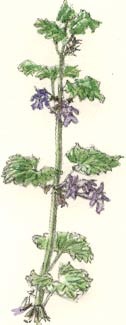 |
Red Dead-nettleThursday, 6th June 2002, West Yorkshire |
![]()
![]()
![]()
![]() Rocks |
History |
Workshop |
Links |
Home Page | Next Page
Rocks |
History |
Workshop |
Links |
Home Page | Next Page
![]()

 Red Dead-nettle, also known a purple dead-nettle, Lamium purpureum, can be leggy, like this specimen from a shady corner of our garden by the hedge (left) or more compact (right) when it grows on open ground. Its square stem is covered by tiny bristly hairs which, viewed through a hand lens, remind me of the downward pointing thorns that help climbing roses to scramble through the hedgerows.
Red Dead-nettle, also known a purple dead-nettle, Lamium purpureum, can be leggy, like this specimen from a shady corner of our garden by the hedge (left) or more compact (right) when it grows on open ground. Its square stem is covered by tiny bristly hairs which, viewed through a hand lens, remind me of the downward pointing thorns that help climbing roses to scramble through the hedgerows.The heart-shaped, blunt-toothed leaves grow in opposite pairs. The botanical name for dead-nettles, Lamium, probably refers to the long throat of the flower as laimos is Greek for throat.
In the past red and white dead-nettles have been cooked like spinach but they're probably don't come into the gourmet class as they've also been used in making pig-swill.
![]()
Richard Bell,
wildlife illustrator
E-mail; 'richard@willowisland.co.uk'
![]() Previous page |
This day in 2000 |
This month |
Nature Diary |
Home Page | Next Page
Previous page |
This day in 2000 |
This month |
Nature Diary |
Home Page | Next Page
![]()